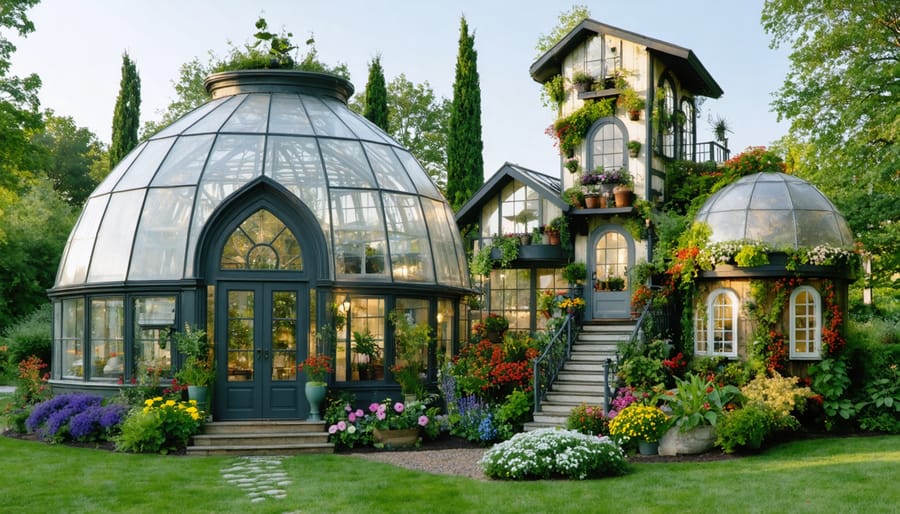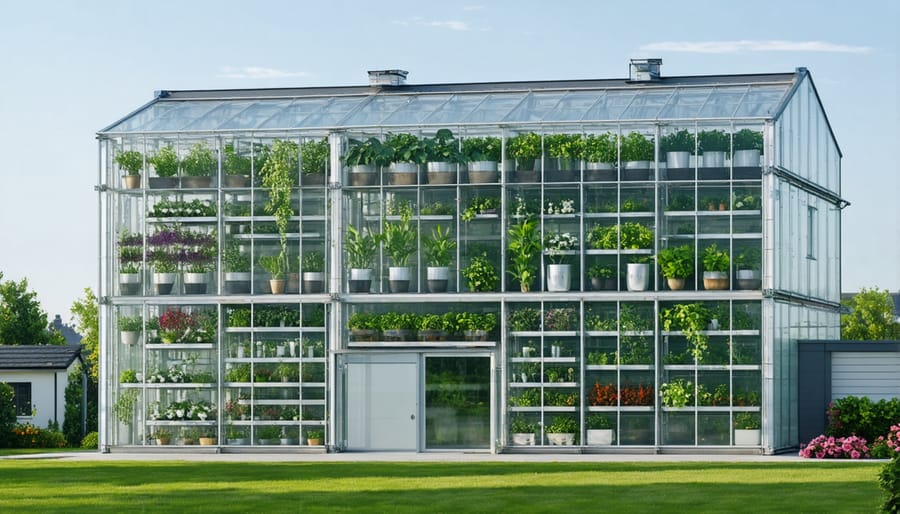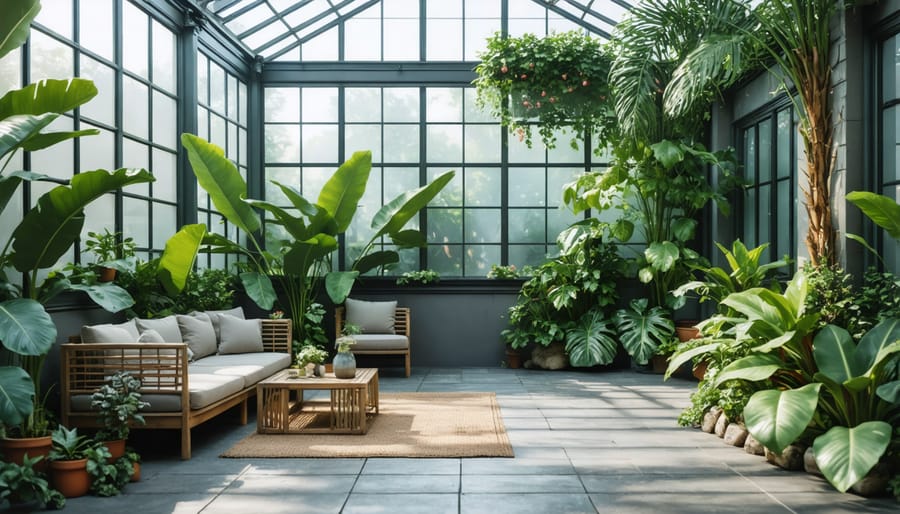Transform Your Garden with These Creative Greenhouse Designs

Transform your gardening space into a sustainable wonderland with unconventional greenhouse designs that challenge traditional thinking. From repurposed shipping containers bursting with vertical gardens to geodesic domes capturing optimal sunlight, innovative greenhouses are revolutionizing how we extend your growing season. Imagine walking into a greenhouse where old windows form a cathedral-like ceiling, or where a spiral design maximizes growing space while creating a stunning visual centerpiece for your backyard. These extraordinary structures don’t just nurture plants; they demonstrate how creativity and sustainability can merge to create productive, beautiful spaces that inspire year-round cultivation. Whether you’re a seasoned gardener or an eco-conscious homeowner, these unusual greenhouse designs offer practical solutions while pushing the boundaries of traditional growing spaces.
Repurposed Materials Make Stunning Greenhouses
Old Window Greenhouses
Transform old windows and doors into charming greenhouse spaces through these creative upcycling projects that blend vintage charm with practical gardening. Salvaged windows, particularly those with divided panes, create stunning visual interest while providing the perfect environment for your plants to thrive. By connecting multiple windows using weatherproof sealant and sturdy frames, you can construct a unique greenhouse that tells a story through its reclaimed materials.
Start by collecting windows of similar sizes from architectural salvage yards, demolition sites, or local restoration projects. Consider incorporating an old door as your entrance, adding character and convenient access. Use weather stripping and silicone caulk to ensure your structure remains water-tight, and add simple shelving inside for plant placement.
These window greenhouses not only reduce landfill waste but also create a beautiful focal point in your garden. The aged glass and weathered frames develop a lovely patina over time, while still maintaining their functionality for growing plants year-round. Plus, each greenhouse becomes a one-of-a-kind creation that reflects your personal style and commitment to sustainable gardening.

Bottle and Container Greenhouses
Transform everyday plastic bottles and containers into an eco-friendly greenhouse that’s both functional and visually striking. By collecting and repurposing clear plastic bottles, you can create walls and roofing that allow plenty of sunlight while giving discarded materials a second life. A typical bottle greenhouse requires approximately 1,500 two-liter bottles for a standard 6×8 foot structure.
The bottles are usually threaded onto bamboo canes or wooden dowels to create panels, which are then secured to a simple frame structure. The natural gaps between bottles provide excellent ventilation, while the air trapped inside each bottle creates an insulating effect. Many gardeners report that these structures maintain temperatures comparable to traditional greenhouses.
For added creativity, mix different bottle sizes and colors to create patterns or designs in your walls. Some gardeners incorporate glass jars and containers for variety, though plastic is typically easier to work with and safer. The end result is not only a practical growing space but also an artistic statement about sustainability that often becomes a conversation piece in the garden.
Remember to thoroughly clean all containers before use and replace any that show signs of degradation over time.
Space-Saving Greenhouse Solutions
Lean-To and Wall-Mounted Designs
For space-conscious gardeners, lean-to and wall-mounted greenhouses offer an ingenious solution that maximizes limited areas while creating an efficient growing environment. These designs attach directly to existing walls of your home, garage, or garden fence, using the structure’s thermal mass to help regulate temperature and reduce heating costs.
A lean-to greenhouse typically features a single-pitched roof that slopes away from the supporting wall, creating a surprisingly spacious growing area without claiming valuable garden space. These structures can be as narrow as 4 feet while still providing ample room for vertical growing systems and hanging baskets.
Wall-mounted designs take space-saving even further, with some models extending just 18 inches from the wall. These compact units are perfect for growing herbs, microgreens, and starter plants. Many feature folding shelves that can be tucked away when not in use, making them ideal for urban gardens or compact yards.
Both styles benefit from the shelter and heat retention provided by the existing structure, often resulting in better growing conditions than traditional freestanding greenhouses. Installation is generally straightforward, though proper waterproofing and secure mounting are essential for long-term success.
Vertical Growing Systems
Vertical growing systems are revolutionizing the way we think about greenhouse space utilization. By growing upward instead of outward, these innovative systems can triple or even quadruple your growing area while maintaining the same footprint. Popular vertical solutions include hydroponic towers, living walls, and tiered growing platforms that transform ordinary greenhouse spaces into productive growing environments.
Many gardeners are incorporating stackable pot systems and hanging gardens that cascade from ceiling-mounted rails. These systems not only maximize space but also create stunning visual displays. Vertical string trellises work wonderfully for climbing vegetables like peas, beans, and cucumbers, while pocket planters attached to walls make excellent homes for herbs and leafy greens.
For the tech-savvy gardener, automated vertical hydroponic systems offer precise control over nutrient delivery and growing conditions. These systems often include built-in lighting and irrigation, making them perfect for year-round growing. Some creative gardeners are even using repurposed materials like old guttering or PVC pipes to create DIY vertical growing channels.
When planning your vertical system, consider factors like light distribution, water drainage, and accessibility for maintenance. Remember to ensure your greenhouse structure can support the additional weight of vertical installations, particularly when fully loaded with plants and water.

Multi-Purpose Greenhouse Structures
Greenhouse-Shed Combinations
Combining a greenhouse with a shed creates the perfect solution for gardeners who want to maximize their outdoor space. These innovative structures merge growing areas with valuable storage space, offering a practical and efficient design that’s becoming increasingly popular among home gardeners.
The typical greenhouse-shed combination features a clear or translucent growing area connected to an enclosed storage section. This setup allows you to keep your gardening tools, pots, and supplies right where you need them while maintaining optimal growing conditions for your plants. Many gardeners find this arrangement particularly convenient during the busy growing season.
These hybrid structures come in various configurations. Some designs split the space equally between greenhouse and storage, while others favor one function over the other. Popular layouts include side-by-side arrangements, where the greenhouse and shed share a wall, and split-level designs with the shed at the back and the greenhouse in front.
The benefits extend beyond mere convenience. The shared wall between sections can help regulate temperature in both spaces, with the solid shed wall providing insulation for the greenhouse area. Additionally, many combinations feature integrated rainwater collection systems, allowing you to harvest and store water for your plants efficiently.
When planning a greenhouse-shed combination, consider installing adjustable shelving systems that can adapt to your changing storage and growing needs throughout the seasons. This flexibility ensures your space remains functional year-round.
Greenhouse-Patio Hybrids
Imagine stepping from your living room into a space that combines the comfort of a patio with the growing power of a greenhouse. Greenhouse-patio hybrids are revolutionizing how we think about outdoor living spaces, offering year-round enjoyment regardless of weather conditions.
These innovative structures typically feature retractable glass panels or sliding doors that can be opened during pleasant weather and closed during cold spells or rain. The key is creating a microclimate that’s comfortable for both plants and people. Many homeowners incorporate cozy seating areas surrounded by tropical plants, herbs, and climbing vines, creating a living oasis that serves multiple purposes.
Popular design elements include temperature-controlled zones, where one area maintains ideal growing conditions while another focuses on human comfort. Strategic placement of thermal mass features, like stone flooring or water features, helps regulate temperature naturally. Some creative homeowners have added outdoor kitchens, dining areas, or even meditation spaces among their growing beds.
The beauty of these hybrid spaces lies in their versatility. During winter months, they provide a sunny retreat where you can garden and relax, while summer brings opportunities for indoor-outdoor living at its finest. Through thoughtful design choices like shade cloths, ventilation systems, and mixed-use planting schemes, these spaces seamlessly blend the functionality of a greenhouse with the comfort of an outdoor room.

Sustainable Features for Unusual Greenhouses
Modern eco-conscious greenhouse designs are revolutionizing how we approach sustainable greenhouse gardening practices. By incorporating innovative features like rainwater harvesting systems, these unique structures maximize natural resources while minimizing environmental impact. Solar-powered ventilation fans and automated misting systems ensure optimal growing conditions without relying heavily on grid electricity.
Many unusual greenhouses now feature living walls that act as natural insulation, helping maintain consistent temperatures while creating additional growing space. Recycled materials play a crucial role in these designs, with old windows, bottles, and even shipping containers finding new life as greenhouse building materials.
Passive solar design elements, such as strategically placed thermal mass walls and underground heat storage systems, help regulate temperature naturally. These features work alongside clever architectural choices like adjustable shade cloths and double-layered polycarbonate panels to create perfect growing environments year-round.
Composting stations integrated directly into greenhouse designs provide a sustainable source of nutrients for plants while reducing waste. Smart irrigation systems with moisture sensors ensure water is used efficiently, while solar-powered LED grow lights extend growing seasons without increasing energy costs.
For those seeking truly sustainable solutions, some innovative designs incorporate aquaponics systems, creating a closed-loop ecosystem where fish waste fertilizes plants, and plants filter water for the fish. These self-sustaining systems demonstrate how unusual greenhouse designs can maximize both efficiency and sustainability.
Thinking outside the box when it comes to greenhouse design can lead to incredible rewards for home gardeners. Unusual greenhouses not only add character to your outdoor space but can also maximize growing potential in ways traditional structures can’t match. Whether you choose a geodesic dome, a vintage window creation, or a vertical garden tower, these unique designs often prove more efficient with space and energy use. They demonstrate that sustainable gardening doesn’t have to follow conventional rules – in fact, breaking those rules mindfully can lead to better results. By embracing creative solutions and alternative materials, you can build a greenhouse that’s perfectly tailored to your needs while reducing your environmental impact. Let your imagination guide you, and remember that today’s unusual greenhouse could become tomorrow’s innovative standard for sustainable growing.

